Understanding Birmingham New Street: A Vital Transport Hub

Introduction
Birmingham New Street is one of the busiest train stations in the United Kingdom, serving as a crucial link in the rail network. Situated in the heart of Birmingham, it plays a vital role in the transport infrastructure of the city and the wider region. As significant travel patterns evolve and urban areas continue to grow, understanding the current developments and implications surrounding Birmingham New Street is essential for commuters, businesses, and urban planners alike.
The Current State of Birmingham New Street
The station, which underwent a major redevelopment completed in 2015, now boasts modern facilities, improved accessibility, and a more efficient layout for easy navigation. With approximately 140,000 passengers using the station daily, Birmingham New Street offers services to destinations across the UK, including London, Manchester, and Glasgow. The station’s location allows for seamless connections with local metro services and bus routes, enhancing its relevance as a transportation hub.
Recent Developments and Events
In recent months, Birmingham New Street has seen a significant increase in passenger numbers, attributed to the lifting of pandemic-related travel restrictions and the resurgence of business and leisure travel. Additionally, the station has been investing in waste reduction initiatives and digital information systems to improve the overall commuter experience. These efforts align with Birmingham’s broader sustainability goals as the city prepares to host several major events, including the upcoming Commonwealth Games.
The Future of Birmingham New Street
Looking ahead, Birmingham New Street is set to play an even more significant role in the region’s transport economy. With the ongoing expansion of rail services, including the introduction of HS2, the station is expected to handle an even greater influx of passengers. Urban planners are also focusing on integrating more cycle lanes and pedestrian-friendly areas to encourage environmentally sustainable methods of transport.
Conclusion
In summary, Birmingham New Street remains a cornerstone of Birmingham’s transport infrastructure, serving as a key point for interconnected travel and commerce. As the station embraces modernisation and sustainability, its significance is poised to grow, benefiting both local residents and visitors alike. The continued investment in Birmingham New Street underscores its importance, not just as a station, but as an essential asset for the city’s future growth and connectivity.








